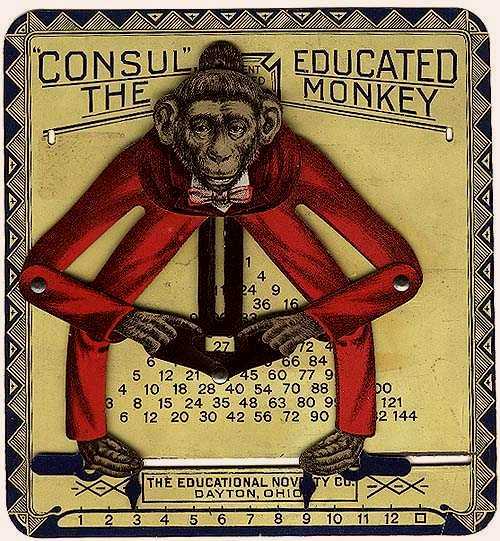Consul The Educated Monkey
Rechenlehrmittel von 1916
|
Im Folgenden steht die englische Bedienungsanleitung. Eine Online-Version finden Sie auf der Titelseite meiner Homepage. Außerdem gibt es eine Seite zu Consuls deutschen Verwandten. Wenn Ihnen der Rechenaffe gefällt, können Sie hier auch das
Programm Consul für Windows herunterladen (ZIP-File
ca. 300 KB).
Eine Flash-Simulation mit Einblick in den Mechanismus gibt es bei
►tang-ram.
Eine Bauanleitung für ein Fischertechnik-Modell finden Sie
hier. |
|
The Educated Monkey What it can do When the monkey’s feet are set to
the point at two numbers, its fingers will locate their product. It teaches the complete
multiplication table. It teaches the complete division
table. It can add, subtract, multiply,
divide, or factor elementary numbers. It is accompanied by an
entertaining and instructive game for children. Its link motion makes a mechanical
puzzle which has advanced students guessing. Try an expert with it. (See back
of addition card.) It is classic in the toy line. A
device which interests both young and old. Directions In order to slide the monkey feed
along the slot very easily, be sure to use both your thumbs, placing a thumb
directly on each monkey foot and your middle fingers on the rivet heads underneath.
(See back of plate.) To multiply, adjust each of the
monkey’s feet to point directly to a number. The monkey’s fingers will then
locate the product of the two numbers. To multiply a number by itself, see
one foot to point at the number and the other at the □. To add, insert the addition card
between the monkey and the plate and carefully locate it in proper position.
Secure it to the plate by the paper fasteners; or, if these are not at hand,
the card can be neatly tied to the plate by passing a band of red twine
through the card and through the small slots in the plate and tying in the
rear. Further directions are on the back of addition card.
It makes
no difference to the monkey whether children are bright or stupid. He never
loses patience at having to answer their questions. Made in U.S.A. By The Educational Toy Manufacturing Co. Springfield, Mass. |
|
MULTE |
M-any U-seful L-essons T-aught E-njoyably |
Brain
power is increased by mental exercises. Turning work into play enables
children to take the necessary exercises. The game Multe can be used to turn
certain kinds of work into play. |
|||||||||||||||||||||
|
The mechanism of the Educated Monkey device
is well adapted for use in playing games. It gives a chance to ingenious
persons to invent a variety of games. It offers teachers an opportunity to
develop a fine art in teaching children numerical tables and stimulating even
the dullest to their best. The game Multe is played as follows: Several
Slips of paper ruled as shown below, should be prepared. In each of the upper
ten spaces there should be written a pair of number, each number being not
greater than 12. The slips are placed in a hat or box. Each contestant draws out a slip and selects
a product for each pair of numbers and writes the selection on the slip, one
product under each pair of numbers. In making these selections, beginners may
be allowed to look at the monkey chart, but mot to operate the monkey. When
finished, each slip may be considered as ten questions and ten answers. An umpire is elected by the players. The
umpire takes a finished slip and calls out the first question and its answer.
Each player who is in doubt as to whether the answer is correct is allowed to
consult his monkey. If the answer is correct, then the next answer is
checked. Whenever an incorrect answer is found, the
umpire cuts with scissors one space from the end of that portion of the slip
which has already been checked. At the end of the game the player having the
longest slip remaining is declared the winner of the game. If each player saves their used slips and
pastes them together end to end, then after a certain number of games, the
contestants with the longest roll of slips is declared champion, for the day,
or the week, as the case may be. If the game is played by a class at school,
the class should be divided into groups, the members of which are about
equally matched in order that no one may become discouraged. Beginners who know nothing of the table
should be told to select their products at random. Enough slips to last for
several games can be prepared in advance. Sample slip is shown here.
|
|||||||||||||||||||||||
|
ß
ADDITION TABLE
à
2
13 4
12 14 6
11 13 15 8
10 12 14 16 10
9 11 13 15 17 12
8 10
12 14 16 18 14
7 9 11 13 15 17 19 16
6 8 10 12 14 16 18 20 18
5 7 9 11 13 15 17 19 21 20
4 6 8 10 12 14 16 18 20 22 22
|
|
Directions To multiply: See directions on the folder To divide: Adjust the number so that one
foot points at divisor and the fingers point at the dividend. The other foot
will be found pointing at the quotient. To factor: Make fingers point at a product.
The feet will point out its factors. To add: Insert the addition table under
monkey and secure in proper position. Then proceed the same as directed for
multiplication. The monkey fingers will point out sum of two numbers instead
of their product. To subtract: Adjust the monkey so that one
foot points at the subtrahend and the fingers point at the minuend. The other
foot will be found pointing at the difference. Note: If the feet stick at any
position, do not force their movement, but loosen by moving the arms.
|

Rechenwerkzeug.de
